1995 PONTIAC BONNEVILLE towing
[x] Cancel search: towingPage 62 of 338
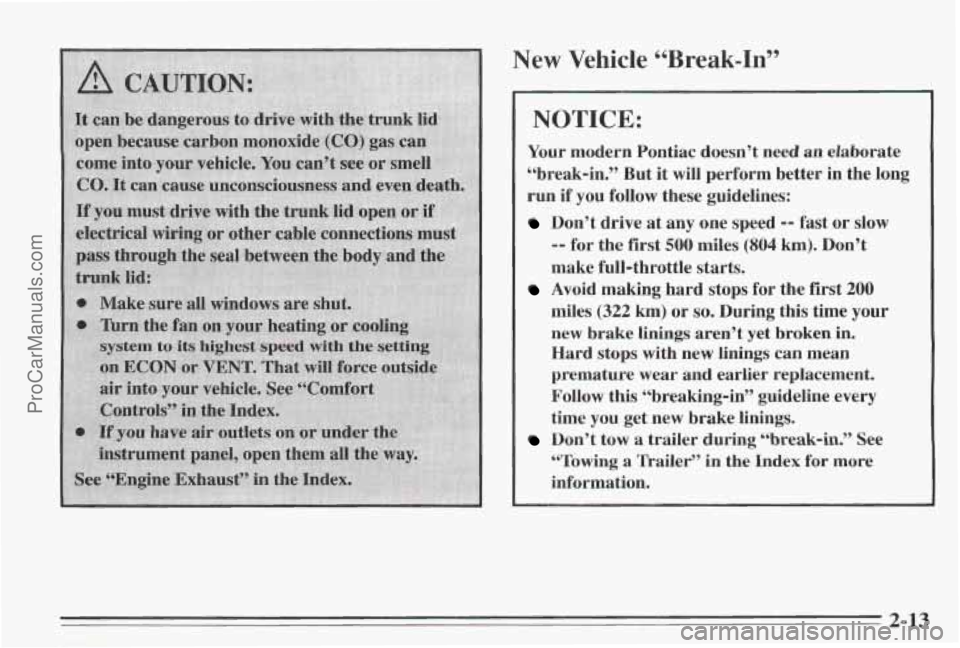
;ystem tu its higlxevt speed with
>n ECON or VENT. That will
air into
your vehicle. See Vornfo
New Vehicle “Break-In”
NOTICE:
Your modern Pontiac doesn’t need an elaborate
“break-in.” But it will perform better in the long
run if you follow these guidelines:
Don’t drive at any one speed -- fast or slow
-- for the first 500 miles (804 km). Don’t
make full-throttle starts.
Avoid making hard stops for the first 200
miles (322 km) or so. During this time your
new brake linings aren’t yet broken in.
Hard stops with new linings can mean
premature wear and earlier replacement.
Follow this “breaking-in” guideline every
time you get new brake linings.
Don’t tow a trailer during “break-in.” See
“Towing a Trailer’’ in the Index
for more
information.
2-13
ProCarManuals.com
Page 65 of 338
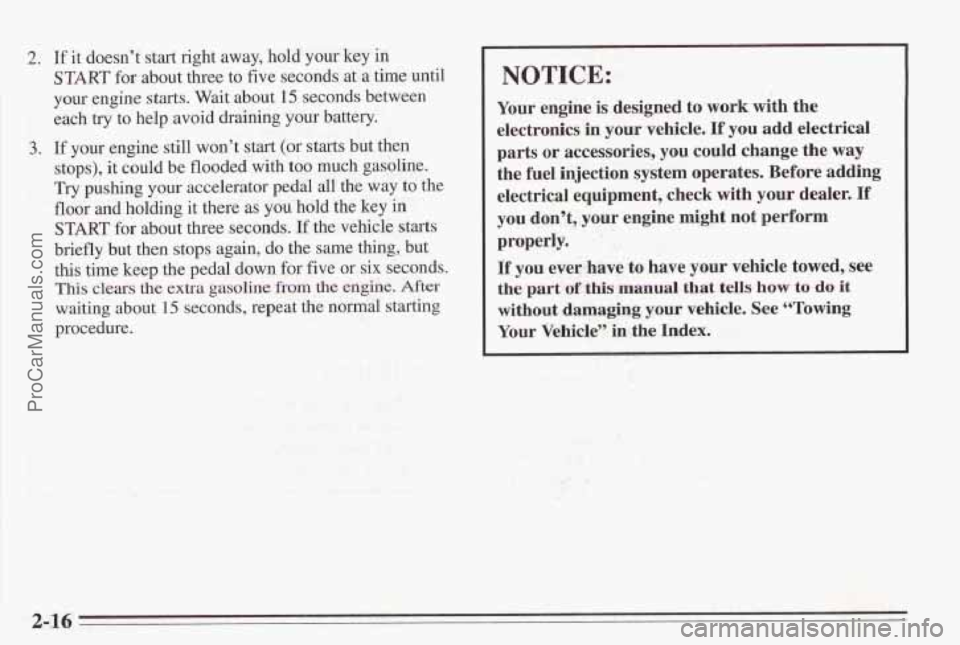
2. If it doesn’t start right away, hold your key in
START for about three to five seconds at a time until
your engine starts. Wait about
15 seconds between
each try
to help avoid draining your battery.
3. If your engine still won’t start (or starts but then
stops), it could be flooded with
too much gasoline.
Try pushing
your accelerator pedal all the way to the
floor and holding it there as you hold
the key in
START for about three seconds. If the vehicle starts
briefly but then stops again, do
the same thing, but
this
time keep the pedal down far five or six seconds.
This clears the extra gasoline €rom the engine. After
waiting about 15 seconds, repeat the nod starting
procedure.
NOTICE:
Your engine is designed to work wkh the
electronics
in your vehicle. If you add electrical
parts or accessories, you could change the way
the fuel injection system operates. Before adding
electrical equipment, check with your dealer.
If
you don’t, your engine might not perform
properly.
If you everhave to have your vehicle towed, see
the part of this manual that tells how to do it
without damaging your vehicle. See “Towing
Your Vehicle” in the lndex.
2-16
ProCarManuals.com
Page 70 of 338
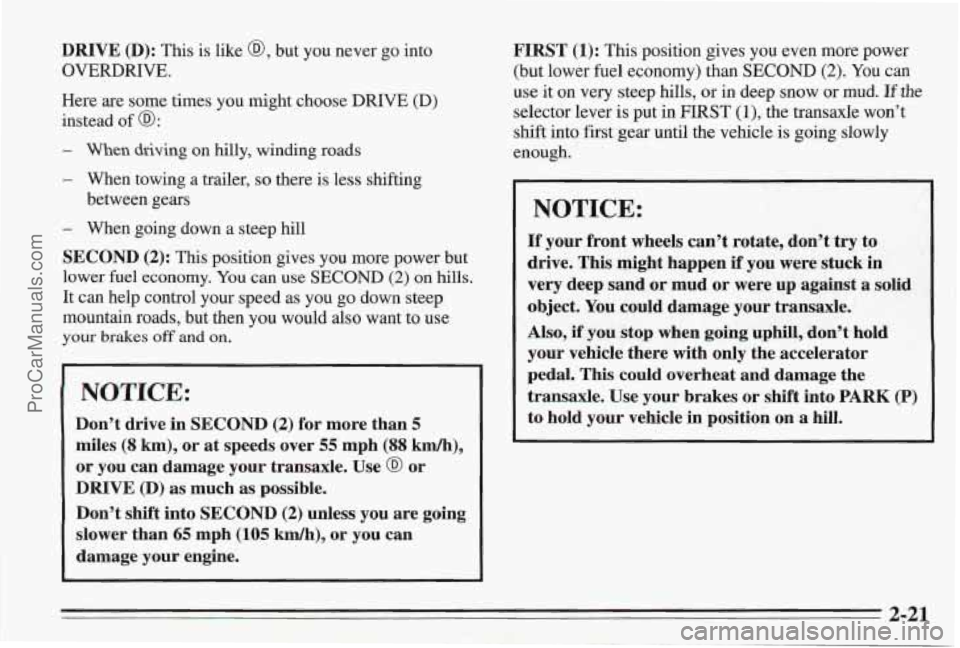
DRIVE (D): This is like @, but you never go into
OVERDRIVE.
Here are some times you might choose DRIVE (D)
instead of
a:
- When driving on hilly, winding roads
- When towing a trailer, so there is less shifting
between gears
- When going down a steep hill
SECOND (2): This position gives you more power but
lower fuel economy. You can
use SECOND (2) on hills.
It can help control your speed as you go down steep
mountain roads, but then you would also want to use
your brakes off and on.
NOTICE:
Don’t drive in SECOND (2) for more than 5
miles (8 km), or at speeds over 55 mph (88 km/h),
or you can damage your transaxle. Use
@ or
DRIVE (D) as much as possible.
Don’t shift into SECOND
(2) unless you are going
slower than
65 mph (105 kd), or you can
damage your engine. FIRST
(1): This
position gives you even more power
(but lower fuel economy) than SECOND
(2). You can
use it on very steep hills, or in deep snow or mud.
If the
selector lever is put in FIRST (l), the transaxle won’t
shift into first gear until
the vehicle is going slowly
enough.
NOTICE:
If your front wheels can’t rotate, don’t try to
drive. This might happen
if you were stuck in
very deep sand or mud or were up against
a solid
object. You could damage your transaxle.
Also,
if you stop when going uphill, don’t hold
your vehicle there with only the accelerator
pedal. This could overheat and damage the
transaxle. Use your brakes or shift into PARK (P)
to hold your vehicle in position on a hill.
2-21
ProCarManuals.com
Page 72 of 338
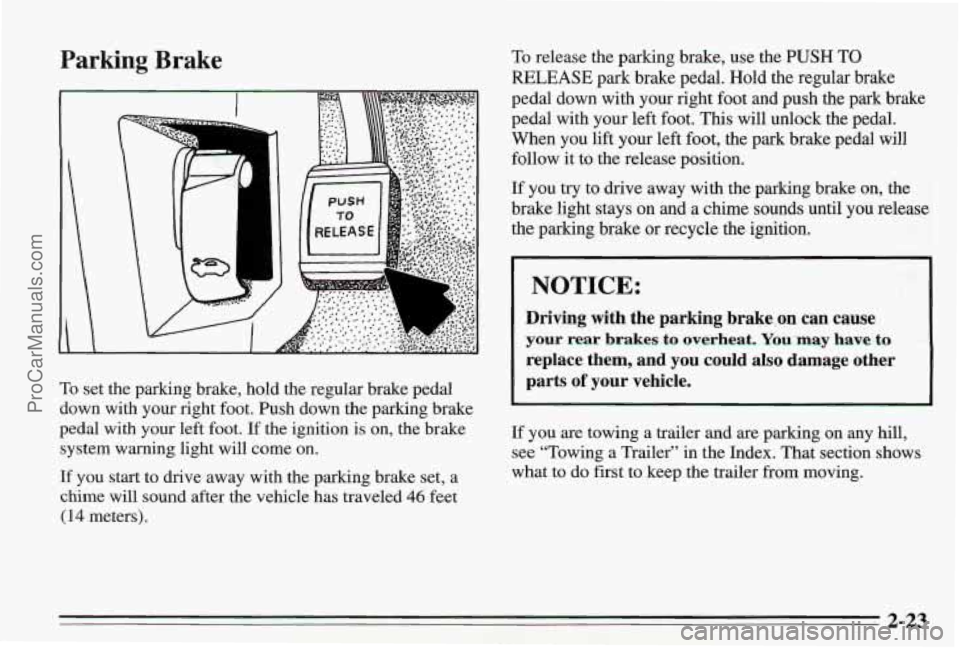
Parking Brake
A
To set the parking brake, hold the regular brake pedal
down with your right foot. Push down the parking brake
pedal with your left foot.
If the ignition is on, the brake
system warning light will come on.
If you start to drive away with the parking brake set, a
chime
will sound after the vehicle has traveled 46 feet
(14 meters). To
release the parking brake, use the
PUSH TO
RELEASE park brake pedal. Hold the regular brake
pedal down with your right foot and push
the park brake
pedal with your left foot. This will unlock the pedal.
When you lift your left foot, the park brake pedal
will
follow it to the release position.
If you try to drive away with the parking brake on, the
brake light stays on and a chime sounds until you
release
the parking brake or recycle the ignition.
I NOTICE:
Driving with the parking brake,on can cause
your rear brakes to overheat. You may have to
replace them, and you could also damage other
parts
of your vehicle.
If you are towing a trailer and are parking. on any hill,
see “Towing a Trailer” in the Index. That section shows
what to do first to keep the trailer
from moving.
2-23
ProCarManuals.com
Page 78 of 338
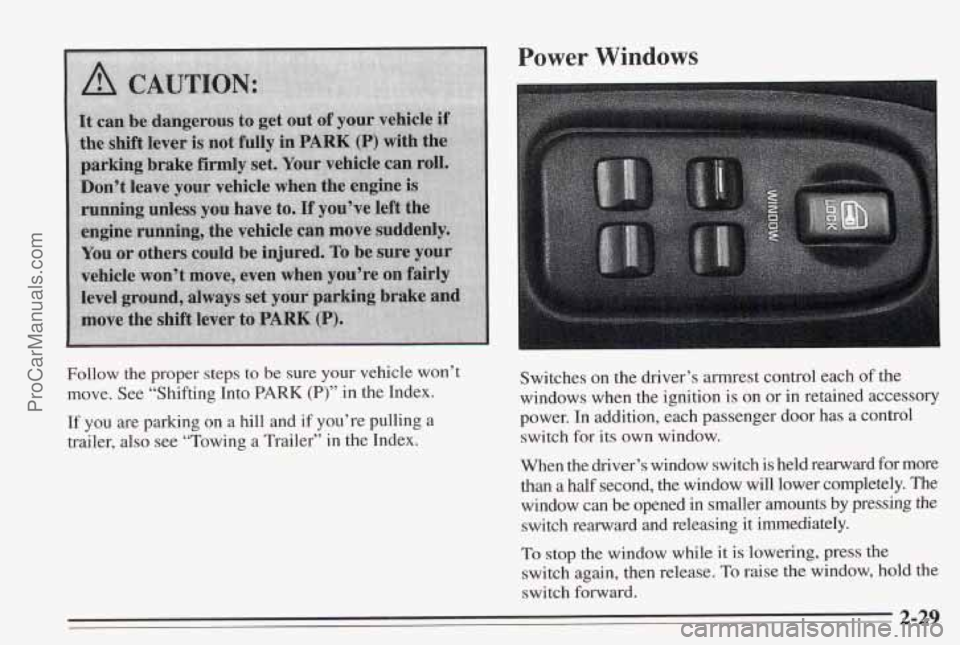
Power Windows
Follow the proper steps to be sure your vehicle won’t
move. See “Shifting Into
PARK (P)” in the Index.
If you are parking on a hill and if you’re pulling a
trailer, also
see “Towing a Trailer” in the Index. Switches on
the driver’s armrest control each
of the
windows when the ignition is on or in retained accessory
power. In addition,
each passenger door has a control
switch for its
own window.
When the driver’s window switch
is held rearward for more
than a half second, the window will lower completely. The
window
can be opened in smaller amounts by pressing the
switch rearward and releasing
it immediately.
TO stop the window while it is lowering, press the
switch again, then release. To raise
the window, hold the
switch
forward.
2-29
ProCarManuals.com
Page 102 of 338
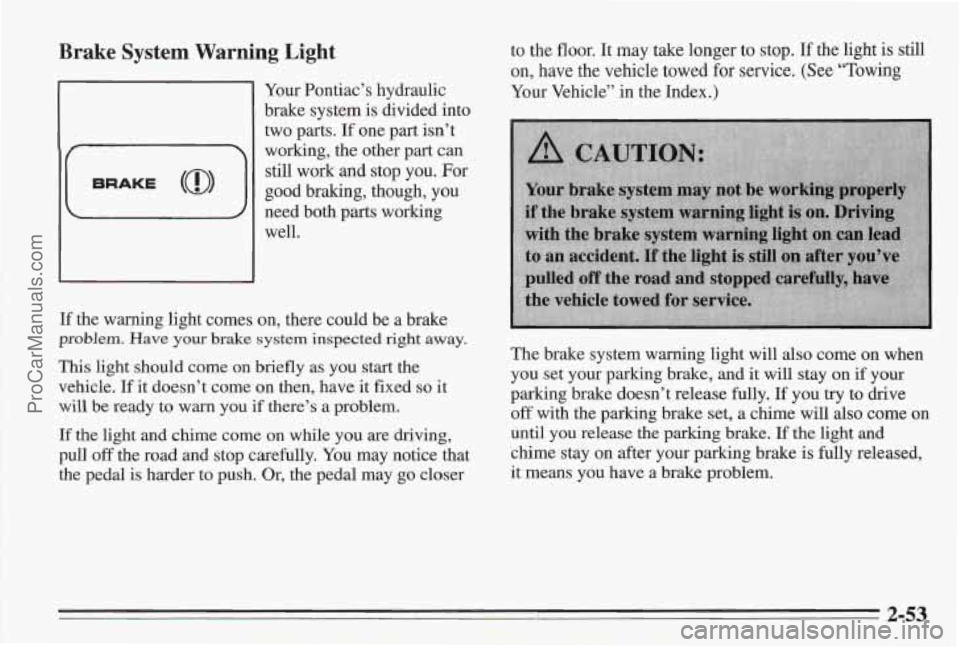
Brake System Warning Light
Your Pontiac’s hydraulic
brake system is divided into
two parts.
If one part isn’t
working, the other part can
still work and stop you.
For
good braking, though, you
need both parts working
well.
If the warning light comes on, there could be a brake
problem. Have your brake system inspected right awav.
This light should come on briefly as you start the
vehicle.
If it doesn’t come on then, have it fixed so it
will be ready to warn you if there’s a problem.
If the light and chime come on while you are driving,
pull
off the road and stop carefully. You may notice that
the pedal is harder to push. Or, the pedal may go closer to
the floor. It may take longer to stop. If the light
is still
on, have the vehicle towed for service. (See “Towing
Your Vehicle” in the Index.)
The brake system warning light will also come on when
you set your parking brake, and it will stay on if your
parking brake doesn’t release fully.
If you try to drive
off with the parking brake set, a chime will also come on
until you release the parking brake. If the light and
chime stay on after your parking brake is fully released,
it means you have a brake problem.
2-53
ProCarManuals.com
Page 173 of 338
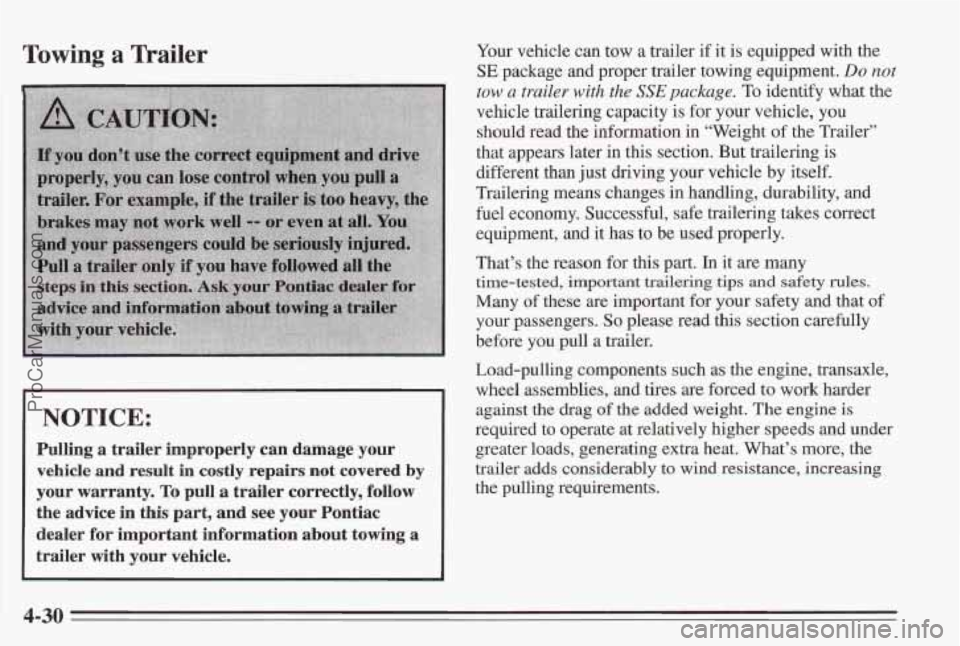
Towing a Trailer
I NOTICE:
Pulling a trailer improperly can damage your
vehicle
and result in costly repairs not covered by
your warranty. To pull a trailer correctly, follow
the
advice in this part, and see your Pontiac
dealer for important information about towing
a
trailer with your vehicle.
Your vehicle can tow a trailer if it is equipped with the
SE package and proper trailer towing equipment. Do not
tow a trailer with the SSE package. To identify what the
vehcle tmilering capacity is for your vehicle, you
should read the information in “Weight of the Trailer”
that appears later
in this section. But trailering is
different than just driving your vehicle by itself.
Trailering means changes in handling, durability, and
fuel economy. Successful, safe trailering takes correct
equipment,
and it has to be used properly.
That’s the reason for
this part. In it are many
time-tested, important trailering tips and safety rules.
Many of these are important for your safety and that of
your passengers. So please read this section carefully
before you pull a trailer.
Load-pulling components such as the engine, transaxle,
wheel assemblies,
and tires are forced to work harder
against the drag
of the added weight. The engine is
required to operate at relatively higher speeds and under
greater loads, generating extra heat. What’s more, the
trailer adds considerably to wind resistance, increasing
the pulling requirements.
4-30
ProCarManuals.com
Page 174 of 338
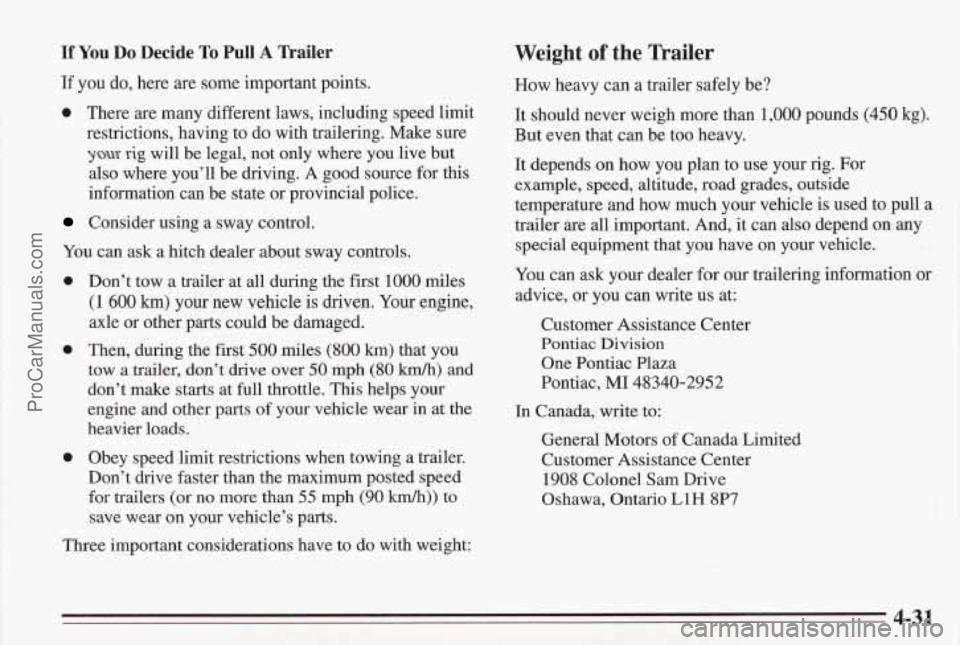
If You Do Decide To Pull A Trailer
If you do, here are some important points.
0 There are many different laws, including speed limit
restrictions, having to do with trailering.
Make sure
your rig will be legal, not only where you live but
also where you’ll be driving. A good source for this
information can be state or provincial police.
Consider using a sway control.
You can ask a hitch dealer about sway controls.
0
0
0
Don’t tow a trailer at all during the first 1000 miles
(1 600 km) your new vehicle is driven. Your engine,
axle or other parts could be damaged.
Then, during the first
500 miles (808 km) that you
tow
a trailer, don’t drive over 50 mph (80 kmk) and
don’t make starts at
full throttle. This helps your
engine and other parts
of your vehicle wear in at the
heavier loads.
Obey speed limit restrictions when towing a trailer.
Don’t drive faster than the maximum posted speed
for trailers (or
no more than 55 mph (90 km/h)) to
save
wear on your vehicle’s parts.
Three important considerations have to do with weight:
Weight of the Trailer
How heavy can a trailer safely be?
It should never weigh more than
1,000 pounds (450 kg).
But even that can be
too heavy.
It depends on how you plan to use your rig. For
example, speed, altitude, road grades, outside
temperature and how much your vehicle is used to pull a
trailer are all important. And, it can also depend on any
special equipment that you have on your vehicle.
You can ask your dealer for our trailering information
or
advice, or you can write us at:
Customer Assistance Center
Pontiac Division
One Pontiac Plaza
Pontiac,
MI 48340-2952
In Canada, write to:
General Motors of Canada Limited
Customer Assistance Center
1908 Colonel Sam Drive
Oshawa, Ontario
L1H 8P7
4-31
ProCarManuals.com